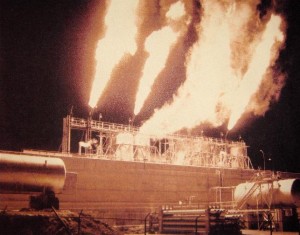The Rocketdyne facility is more poisoned than anyone knew. Now residents and community leaders of the northwest San Fernando Valley and Ventura County supervisors want more testing before new homes get any closer.
By Michael Collins
Los Angeles CityBeat/ValleyBeat – July 22, 2004
 [KB Home’s Runkle Canyon development is now called Arroyo Vista at the Woodlands.]
[KB Home’s Runkle Canyon development is now called Arroyo Vista at the Woodlands.]
“I didn’t know anything when I worked up at Rocketdyne, I just didn’t know anything,” said Bonnie Klea. “I didn’t have a clue how dangerous it was up there.” The West Hills resident sure knows now. Years after working at Rocketdyne’s sprawling Santa Susana Field Laboratory (SSFL) high in the hills between the San Fernando and Simi valleys, she came down with a rare bladder cancer in 1995. Ever since, she has been a vocal critic of the military and aerospace company now owned by the largest private employer in Southern California, Boeing.
Klea has fought Rocketdyne tooth and nail and has little to show for it. Her successful struggle against cancer is another story. “I had surgery and was in the hospital nine times in nine months. I had the tumor taken out. I had four different kinds of chemotherapy and I did a full term of radiation on top of that. I didn’t want it to come back so I said ‘give it all to me.’”
Of the cancer itself, Klea says, “It’s in the neighborhood. On my little street alone, I have two neighbors that have had bladder cancer.” Sixteen cancers have afflicted residents in 15 homes on Klea’s block. A 1990 state health department survey of cancer records showed elevated levels of bladder cancer in the census tracts closest to the lab. That includes tract 1132 where Klea lives, less than two miles from SSFL. The 2,668-acre lab has an abysmal pollution record of partial nuclear meltdowns, radiological mishaps, and chemical contamination, making it one of the most fought-over environmental cleanup sites in the nation.

Regardless, three housing projects are popping up within two miles of SSFL including a massive development at the former Runkle Ranch and the proposed Colton Lee Communities, both in Simi Valley. On the Los Angeles County side of the border, the Dayton Canyon Estates proposes new homes along a creek that carries Rocketdyne runoff through it. Even more bold, Boeing still hopes to release the lab land for unrestricted use including housing developments.
But new government data reveals pollution problems at SSFL are far worse than ever before realized. Groundwater under the lab is hot with dangerous levels of radioactive tritium. Rocketdyne dioxins register hundreds of thousands of times higher than previously known. The rocket fuel oxidizer perchlorate has been discovered at unprecedented levels resulting in extensive recent excavation of part of the lab, and the chemical is now found in numerous offsite wells. Trichloroethylene (TCE), a toxic rocket engine solvent, was found in SSFL soil vapor billions of times over limits considered even moderately safe for humans. And the volatile organic compound is slowly spreading offsite.
Against this gloomy backdrop, Ventura County Supervisor Linda Parks is attempting to enact regulations that would have developers within two miles of rocket testing facilities test for perchlorate and TCE before breaking ground. Rocketdyne, which is in east Ventura County and releases lab effluent into Parks’s district, is fighting the initiative. Boeing is also attempting to prove that evidence of offsite pollution is either faulty or cannot be traced back to SSFL, apparently in order to keep cleanup costs and mounting legal bills from rocketing out of sight. The company seems confident that through its largess and cozy government connections, it can succeed.
“Even without these shocking new facts, what we already know should be greatly concerning not just to the hundreds of thousands of people living in the shadow of Rocketdyne, but to all of us,” said Jonathan Parfrey, director of the L.A.-based public health organization Physicians for Social Responsibility. “Although the meltdowns at Rocketdyne were smaller than the one at Three Mile Island, at least that disaster was largely held at bay by a containment vessel. The reactors at Rocketdyne had none. Add to that the inconceivable amount of chemicals polluting the lab, and what you’ve got is a never-ending nightmare of epic proportions.”
Nightmare indeed. The 1979 Three Mile Island disaster in Pennsylvania was the worst known nuclear meltdown in U.S. history. The partial meltdown there took place in a concrete and steel encased structure designed to prevent lethal radiation from escaping into the environment. Rocketdyne never had that kind of protection.
Hot Zone
In 1957, Rocketdyne debuted the nation’s first commercial nuclear reactor, the Sodium Reactor Experiment (SRE), which supplied electricity to over a thousand folks in the then-tiny town of Moorpark. The SRE experienced a partial meltdown in the summer of 1959, in which a third of the reactor core melted and lethal radioactive gases spewed from the unfortified building.
The SRE partial meltdown released 15 to 260 times more radiation to the surrounding environment than did Three Mile Island, according to the Santa Barbara-based law firm of Capello & Noël. The firm represents over 300 individuals in lawsuits against Boeing and Rockwell International, the lab’s original owner. On June 8, the U.S. District Court, Central District of California, denied Boeing’s efforts to dismiss these radiation claims. The lawsuits argue that the SRE melt, in part, may have poisoned its clients and that the issue deserves to go to trial.
Also June 8, Rocketdyne officials held a press conference in Simi Valley to explain its first-ever findings of dangerous levels of radioactivity in SSFL groundwater. Radioactive tritium discovered in samples taken in March measured 80,000 picocuries per litter, four times the national drinking water limit. The company admitted that lab workers had been drinking the groundwater for decades. Rocketdyne Division Director for Safety, Health & Environmental Affairs, Steve Lafflam, acknowledged that the lab used the groundwater for drinking from 1948 until at least 1975 when employees began complaining of a rusty taste, according to Klea who attended the press conference. (Lafflam declined CityBeat‘s repeated requests for comment for this story.)
Klea, 61, used to drink SSFL tap water and brushed her teeth with it when she was a secretary at Rocketdyne from 1962 to 1971. “And then when I heard from Lafflam that we drank the groundwater – it’s just disgusting – I asked him. I said ‘Steve, this is the first time I ever heard somebody from your company admit that the employees drank contaminated water.’ ‘I didn’t say it was contaminated,’ he said.”
Wicked Brew
But, apparently, it is, and the contaminants aren’t just radioactive. On June 9, the state Department of Toxic Substances Control (DTSC) released its most comprehensive testing data to date for SSFL chemical pollution – over 10,000 samples and 19,000 analyses. The agency, which is responsible for chemical toxin oversight at the lab, looked at water, soil, and soil vapor readings. Much of the water data came from 132 new wells installed on the property from 2001 to 2004 (See test results sidebar at www.lacitybeat.com). Here are some of the more startling results:
• Trichloroethylene was used extensively at SSFL to clean rocket engines, test stands, and other machinery from 1954 through 1993. Before they thought to recycle the stuff, in 1962 for financial reasons, 1.73 million gallons slopped onto the ground and was sluiced into unlined troughs. A reported 520,000 gallons of it soaked into the groundwater and bedrock. DTSC data shows SSFL groundwater containing up to 79,000 parts per billion (ppb) of TCE, 15,800 times the EPA’s “maximum contaminant level” of 5 ppb. The chemical affects the liver, kidneys, immune function, and fetal development – large doses may cause death.
• CityBeat has located the offsite well with the highest TCE concentrations several hundred yards away from the entrance to SSFL. The “RD-38” well, which looks like a water heater with slits in it, had a TCE reading of 690 ppb last year. The well overlooks Woolsey Canyon, which leads down towards the homes of over 23,600 residents in Box Canyon to the northeast, the apparent direction of the TCE plume’s slow migration.
• TCE soil concentrations at the site are also alarming. At the Alfa rocket test stand, ´´ TCE was found at 1,820,000 ppb in the dirt, 34,340 times the ‘preliminary remediation goal’ (PRG) of 53 ppb for soil.
• TCE vapors possibly present even more of a toxic threat. The chemical volatilizes from shallow groundwater through so-called “vapor pathways” in the soil. Breathing small amounts of TCE may cause dizziness, lung irritation, headaches, difficulty concentrating, and poor coordination. Inhaling large quantities may result in unconsciousness, impaired heart function, and death.
• According to information provided to CityBeat by a DTSC environmental geoscientist, TCE vapors could spell very bad news for Rocketdyne and the field lab’s adjacent neighbors. According to the calculations of this geoscientist, who requested anonymity for this article, TCE is five times more dangerous in the air than it is in the water at the same levels of Contamination. EPA studies from 2002 also show that the vaporized toxin may actually be up to 65 times more poisonous than previously thought.
The highest TCE soil vapor reading at SSFL is 500,000 ppb underneath the lab’s Liquid Oxygen Plant. Using the geoscientist’s calculations, the TCE soil vapor under the plant is over 29.4 billion times the preliminary remediation goal. Despite the danger that TCE poses, Rocketdyne’s current cleanup rate for the solvent in SSFL groundwater is 10 gallons a year. At this rate, it will take over 50,000 years to remove.
One of the other SSFL contaminants now the focus of nationwide concern is perchlorate. The rocket fuel oxidizer made headlines June 22 after the Environmental Working Group released its report which found perchlorate in 31 out of 32 milk samples purchased from grocery stores in Los Angeles and Orange counties. The group also discovered that the California Department of Food and Agriculture had found perchlorate in all 32 milk samples collected in Alameda, Sacramento, and San Joaquin counties. Half of those samples exceeded the amount that the state considers safe for drinking water, 6 ppb.












Recent Comments